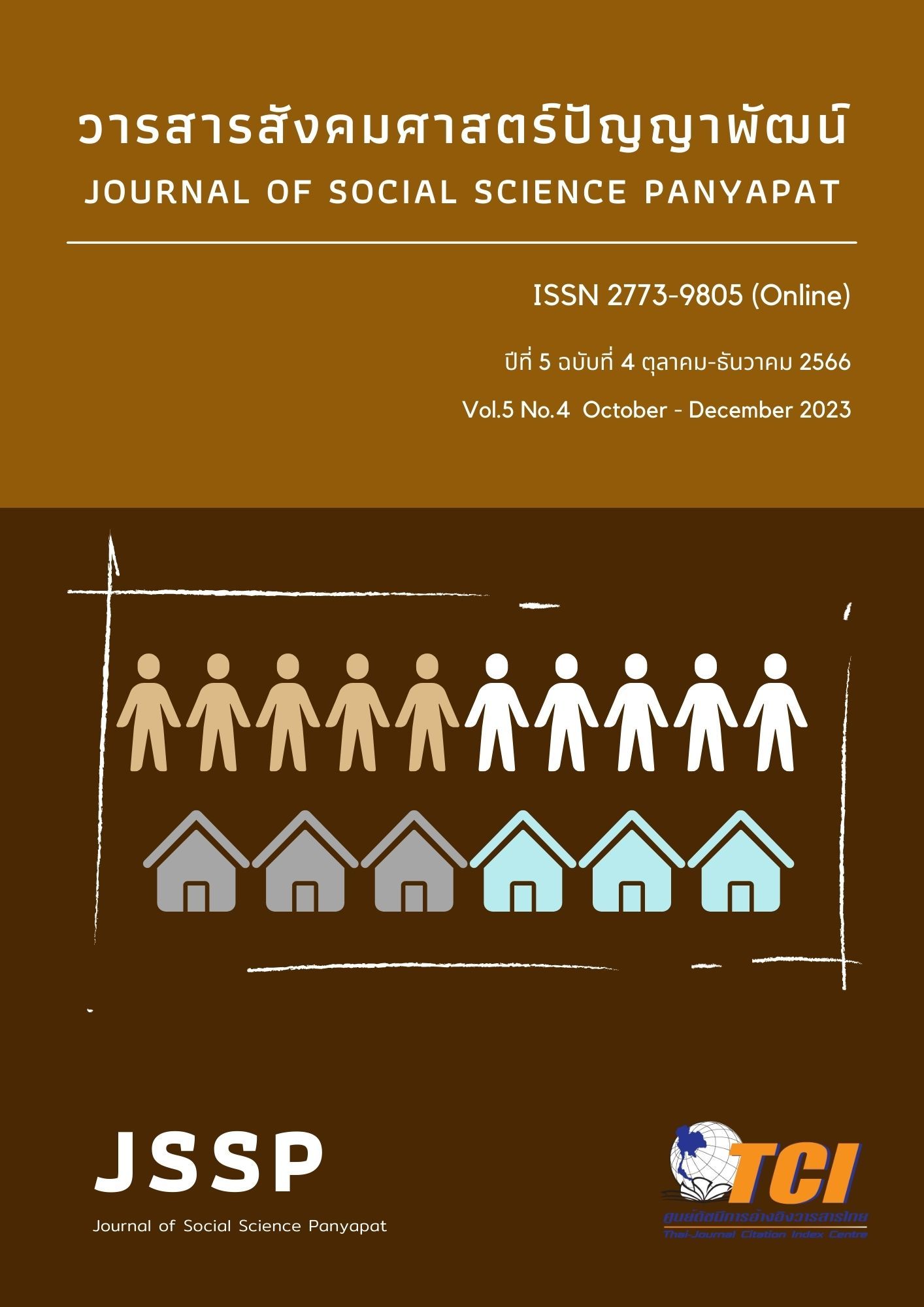อัตวิสัยต่อการรับรู้ความรุนแรงในครอบครัวของสมาชิกเครือข่ายทางสังคม ตำบลห้วยสามพาด อำเภอประจักษ์ศิลปาคม จังหวัดอุดรธานี
คำสำคัญ:
เครือข่ายทางสังคม, ความรุนแรงในครอบครัว, การรับรู้บทคัดย่อ
เครือข่ายทางสังคมเป็นกลไกภาคีหนึ่งที่สำคัญสำหรับการจัดการปัญหาความรุนแรงในครอบครัวของชุมชนพื้นที่ แม้ว่าเหตุการณ์หรือประสบการณ์ปัญหาจะเกิดขึ้นในบริบทของครัวเรือน ซึ่งปัญหาดังกล่าวก็เป็นปรากฎการณ์ระดับโลกที่จำเป็นต้องจัดการโดยเฉพาะอย่างยิ่งเมื่อผนวกกับห้วงเวลาของการแพร่ระบาดของไวรัสโคโรน่า 2019 เป็นต้นมา การศึกษานี้มีวัตถุประสงค์หนึ่งเพื่อศึกษาการรับรู้ของเครือข่ายทางสังคมที่มีต่อความรุนแรงในครอบครัวของพื้นที่ โดยใช้ตำบลห้วยสามพาด อำเภอประจักษ์ศิลปาคม จังหวัดอุดรธานีเป็นกรณีศึกษา ด้วยวิธีการศึกษาเชิงคุณภาพผ่านการวิธีการเก็บรวบรวมข้อมูลคือ การสัมภาษณ์กับบุคคล จำนวน 14 คน และการสนทนากลุ่มกับเครือข่าย จำนวน 6 คน โดยใช้แนวคิดเครือข่ายทางสังคมและแนวคิดนิเวศวิทยาสังคมเชื่อมโยงกับความรุนแรงในครอบครัว ผลการศึกษาพบว่า การรับรู้ของเครือข่ายทางสังคมเป็นอัตวิสัยของประสบการณ์ของสมาชิกเครือข่ายที่ให้มุมมองที่มีต่อสถานการณ์ความรุนแรงในครอบครัวที่แตกต่างกันภายใต้ห้วงเวลาวิกฤติโควิด-19 ที่คาบเกี่ยวกับสาเหตุ ผลกระทบ มุมมอง และระบบคุณค่าที่มีต่อความรุนแรงในครอบครัวของพื้นที่ ซึ่งการรับรู้เป็นจุดเริ่มต้นของการวิเคราะห์เพื่อพิจารณาสู่แนวทางการจัดการความรุนแรงต่อไป
เอกสารอ้างอิง
กรมกิจการสตรีและสถาบันครอบครัว กระทรวงการพัฒนาสังคมและความมั่นคงของมนุษย์. (2561). รายงานข้อมูลสถานการณ์ด้านความรุนแรงในครอบครัวกับรายงานตามมาตรา 17 แห่งพระราชบัญญัติคุ้มครองผู้ถูกกระทำด้วยความรุนแรงในครอบครัวพ.ศ. 2550 ประจำปี 2561. สืบค้น 12 มกราคม 2566. จาก https://dwf.go.th/contents/48156.
กองพัฒนานโยบายและนวัตกรรม กระทรวงการพัฒนาสังคมและความมั่นคงของมนุษย์. (2564). รายงานสถานการณ์และแนวโน้มทางสังคม: ความรุนแรงในครอบครัว. สืบค้น 12 มกราคม 2566. จาก https://opendata.nesdc.go.th/dataset/32693234-bb88-478e-b01d-f9af218a9cce/resource/d710fe3f-7b48-4d11-a3f0-22db476d6b1a/download/4.-..pdf.
กองสวัสดิการสังคม องค์การบริหารส่วนตำบลห้วยสามพาด อำเภอประจักษ์ศิลปาคม จังหวัดอุดรธานี. (2566). งานด้านความรุนแรงต่อเด็กและสตรี. อุดรธานี: องค์การบริหารส่วนตำบลห้วยสามพาด จังหวัดอุดรธานี.
กาญจนา แก้วเทพ. (2560). เครื่องมือทำงานวัฒนธรรมชุมชนและสื่อพิธีกรรมศึกษา. กรุงเทพฯ: ศูนย์มานุษยวิทยาสิรินธร (องค์การมหาชน).
ดวงฤดี สุริยันยงค์, อมลวรรณ วีระธรรมโม และ จรัส อติวิทยาภรณ์. (2557). ปัจจัยในการนำนโยบายความมั่นคงของชีวิตและสังคมประเด็นการคุ้มครองสตรีที่ถูกกระทำด้วยความรุนแรงในครอบครัว ของ บุคลากรไปปฏิบัติในจังหวัดสงขลา. วารสารอินทนิลทักษิณสาร มหาวิทยาลัยทักษิณ, 9(2), 135-156.
ปุณยวัจน์ ไตรจุฑากาญจน์. (2564). ความรุนแรงต่อผู้สูงอายุ: สถานการณ์ สาเหตุ และการรับมือ. วารสารสังคมศาสตร์, 51(2), 167-192.
มูลนิธิหญิงชายก้าวไกล กรมกิจการสตรีและสถาบันครอบครัว กระทรวงการพัฒนาสังคมและความมั่นคงของมนุษย์ และสำนักงานกองทุนสนับสนุนการสร้างเสริมสุขภาพ (สสส.). (2563). การสร้างและพัฒนาพื้นที่ปลอดภัยทางสังคมโดยชุมชนชนบท ชุมชนเมือง และชุมชนแรงงานเขตอุตสาหกรรม. สืบค้น 12 มกราคม 2566. จาก https://cmudc.library.cmu.ac.th/frontend/Creator/personDc/95551.
วิชัย รูปขำดี. (2554). บทบาทของท้องถิ่นกับการแก้ไขความรุนแรงทางสังคม. วารสารสถาบันพระปกเกล้า, 9(1), 89-100.
สุรีย์ฉาย พลวัน และ มาดี ลิ่มสกุล. (2565). การขยายพื้นที่ชุมชนในการดำเนินโปรแกรมการทำงานกับผู้กระทำความรุนแรงในครอบครัวเพื่อป้องกันการกระทำซ้ำ. วารสารมนุษยศาสตร์และสังคมศาสตร์ มหาวิทยาลัยพะเยา, 10(1), 338-355.
Atkinson, R. (2006). Padding the bunker: strategies of middle-class disaffiliation and colonisation in the city. Urban studies, 43(4), 819-832.
Babbie, E. R. (2013). The practice of social research. (13th ed.). London: International Thomson Publishing Services.
Borgatti, S. P., & Ofem, B. (2010). Social network theory and analysis. Retrieved 2 July 2023. from https://www.researchgate.net/profile/Stephen-Borgatti/publication/298097232_Overview_Social_network_theory_and_analysis/links/5715549508ae0f1a39b1a475/Overview-Social-network-theory-and-analysis.pdf.
Card, D., & Dahl, G. B. (2011). Family violence and football: The effect of unexpected emotional cues on violent behavior. The quarterly journal of economics, 126(1), 103-143.
Castells, M. (2004). The Network Society: A Cross-cultural Perspective. Cheltenham, United Kingdom: Edward Elgar.
Çepni, E. (2017). Transforming Education for a Transition into Human-centered Economy and Post-normal Times. Cadmus, 3(3), 24-41.
Cosimo, S. D. (2012). Domestic violence: Legal sanctions and recidivism rates among male perpetrators. Texas: LFB Scholarly Pub. LLC.
Federici, S. (2018). Witches, witch-hunting, and women. New York: PM Press.
Golu, F. (2017). A Multidimensional Perspective on Domestic Violence: Violence Against Women and Child Maltreatment. In Ortiz, M. (Eds.). Domestic Violence: Prevalence, Risk Factors and Perspectives. (pp. 33–68). Hauppauge, New York: Nova Science Publishers, Inc..
Granovetter, M. S. (1973). The strength of weak ties. American journal of sociology, 78(6), 1360-1380.
Healy, S. (2011). Post-normal science in post normal times. Futures, 43(2), 202-208.
Henke, A., & Hsu, L. (2022). COVID-19 and domestic violence: Economics or isolation?. Journal of family and economic issues, 43(2), 296-309.
James, S. E., Johnson, J., & Raghavan, C. (2004). “I couldn’t go anywhere” contextualizing violence and drug abuse: a social network study. Violence against women, 10(9), 991-1014.
Miranda, R. B., & Lange, S. (2020). Domestic violence and social norms in Norway and Brazil: A preliminary, qualitative study of attitudes and practices of health workers and criminal justice professionals. PloS one, 15(12), e0243352.
Mormina, M. (2022). Knowledge, expertise and science advice during covid-19: In search of epistemic justice for the ‘wicked’problems of post-normal times. Social Epistemology, 36(6), 671-685.
Moser, C. O., & McIlwaine, C. (2006). Latin American urban violence as a development concern: towards a framework for violence reduction. World development, 34(1), 89-112.
Muggah, R., & Savage, K. (2012). Urban violence and humanitarian action: engaging the fragile city. Retrieved 2 July 2023. from https://igarape.org.br/en/urban-violence-and-humanitarian-action/.
Netto, L. D. A., Moura, M. A. V., Araujo, C. L. F., Souza, M. H. D. N., & Silva, G. F. (2017). Social support networks for women in situations of violence by an intimate partner. Texto & Contexto Enfermagem, 26(2), 1-11.
Nicolescu, B. (2014). Methodology of transdisciplinarity. World futures, 70(3-4), 186-199.
Ogbe, E., Jbour, A., Rahbari, L., Unnithan, M., & Degomme, O. (2021). The potential role of network-oriented interventions for survivors of sexual and gender-based violence among asylum seekers in Belgium. BMC public health, 21(1), 1-15.
Özbay, Ö., & Özcan, Y. Z. (2008). A test of Hirschi's social bonding theory: A comparison of male and female delinquency. International journal of offender therapy and comparative criminology, 52(2), 134-157.
Renzetti, C. M. (2009). Economic stress and domestic violence. Retrieved 2 July 2023. from https://uknowledge.uky.edu/cgi/viewcontent.cgi?article=1000&context=crvaw_reports.
Thomas, K. A., Goodman, L. A., Vainer, E. S., Heimel, D., Barkai, R., & Collins-Gousby, D. (2018). “No sacred cows or bulls”: The story of the domestic violence program evaluation and research collaborative (DVPERC). Journal of Family Violence, 33, 537-549.
True, J. (2010). The political economy of violence against women: A feminist international relations perspective. Australian Feminist Law Journal, 32(1), 39-59.
World Bank. (2011). Violence in the city: Understanding and supporting community responses. Washington DC: World Bank.
ดาวน์โหลด
เผยแพร่แล้ว
รูปแบบการอ้างอิง
ฉบับ
ประเภทบทความ
สัญญาอนุญาต
ลิขสิทธิ์ (c) 2023 วารสารสังคมศาสตร์ปัญญาพัฒน์

อนุญาตภายใต้เงื่อนไข Creative Commons Attribution-NonCommercial-NoDerivatives 4.0 International License.


